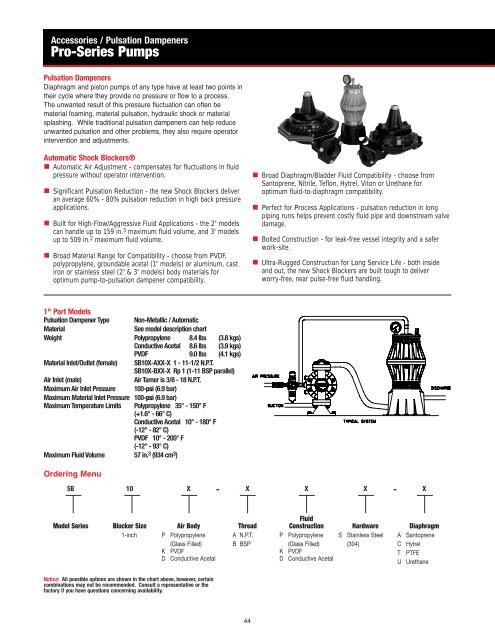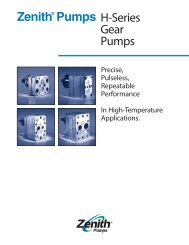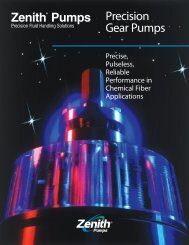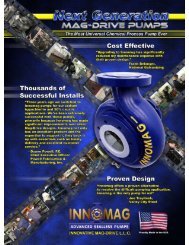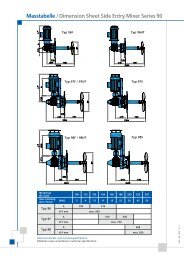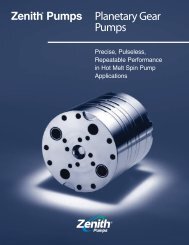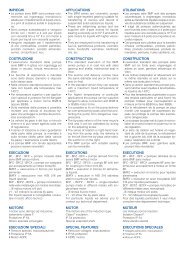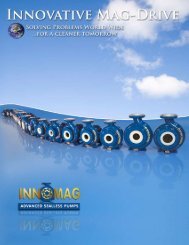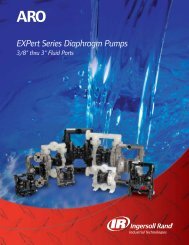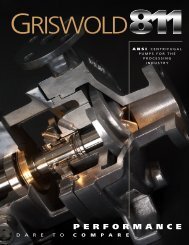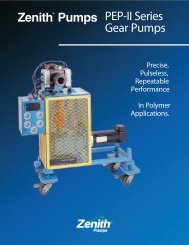ARO Diaphragm and Piston Pumps
ARO Diaphragm and Piston Pumps
ARO Diaphragm and Piston Pumps
Create successful ePaper yourself
Turn your PDF publications into a flip-book with our unique Google optimized e-Paper software.
Accessories / Pulsation Dampeners<br />
Pro-Series <strong>Pumps</strong><br />
Pulsation Dampeners<br />
<strong>Diaphragm</strong> <strong>and</strong> piston pumps of any type have at least two points in<br />
their cycle where they provide no pressure or flow to a process.<br />
The unwanted result of this pressure fluctuation can often be<br />
material foaming, material pulsation, hydraulic shock or material<br />
splashing. While traditional pulsation dampeners can help reduce<br />
unwanted pulsation <strong>and</strong> other problems, they also require operator<br />
intervention <strong>and</strong> adjustments.<br />
Automatic Shock Blockers®<br />
Automatic Air Adjustment - compensates for fluctuations in fluid<br />
pressure without operator intervention.<br />
Significant Pulsation Reduction - the new Shock Blockers deliver<br />
an average 60% - 80% pulsation reduction in high back pressure<br />
applications.<br />
Built for High-Flow/Aggressive Fluid Applications - the 2" models<br />
can h<strong>and</strong>le up to 159 in. 3 maximum fluid volume, <strong>and</strong> 3" models<br />
up to 509 in. 2 maximum fluid volume.<br />
Broad Material Range for Compatibility - choose from PVDF,<br />
polypropylene, groundable acetal (1" models) or aluminum, cast<br />
iron or stainless steel (2" & 3" models) body materials for<br />
optimum pump-to-pulsation dampener compatibility.<br />
Broad <strong>Diaphragm</strong>/Bladder Fluid Compatibility - choose from<br />
Santoprene, Nitrile, Teflon, Hytrel, Viton or Urethane for<br />
optimum fluid-to-diaphragm compatibility.<br />
Perfect for Process Applications - pulsation reduction in long<br />
piping runs helps prevent costly fluid pipe <strong>and</strong> downstream valve<br />
damage.<br />
Bolted Construction - for leak-free vessel integrity <strong>and</strong> a safer<br />
work-site.<br />
Ultra-Rugged Construction for Long Service Life - both inside<br />
<strong>and</strong> out, the new Shock Blockers are built tough to deliver<br />
worry-free, near pulse-free fluid h<strong>and</strong>ling.<br />
1" Port Models<br />
Pulsation Dampener Type Non-Metallic / Automatic<br />
Material<br />
See model description chart<br />
Weight Polypropylene 8.4 lbs (3.8 kgs)<br />
Conductive Acetal 8.6 lbs (3.9 kgs)<br />
PVDF 9.0 lbs (4.1 kgs)<br />
Material Inlet/Outlet (female) SB10X-AXX-X 1 - 11-1/2 N.P.T.<br />
SB10X-BXX-X Rp 1 (1-11 BSP parallel)<br />
Air Inlet (male)<br />
Air Tamer is 3/8 - 18 N.P.T.<br />
Maximum Air Inlet Pressure 100-psi (6.9 bar)<br />
Maximum Material Inlet Pressure 100-psi (6.9 bar)<br />
Maximum Temperature Limits Polypropylene 35° - 150° F<br />
(+1.6° - 66° C)<br />
Conductive Acetal 10° - 180° F<br />
(-12° - 82° C)<br />
PVDF 10° - 200° F<br />
(-12° - 93° C)<br />
Maximum Fluid Volume 57 in. 3 (934 cm 3 )<br />
Ordering Menu<br />
SB 10 X - X X X - X<br />
Model Series<br />
Blocker Size<br />
1-inch<br />
P<br />
K<br />
D<br />
Air Body<br />
Polypropylene<br />
(Glass Filled)<br />
PVDF<br />
Conductive Acetal<br />
Thread<br />
A N.P.T.<br />
B BSP<br />
P<br />
K<br />
D<br />
Fluid<br />
Construction<br />
Polypropylene<br />
(Glass Filled)<br />
PVDF<br />
Conductive Acetal<br />
S<br />
Hardware<br />
Stainless Steel<br />
(304)<br />
A<br />
C<br />
T<br />
U<br />
<strong>Diaphragm</strong><br />
Santoprene<br />
Hytrel<br />
PTFE<br />
Urethane<br />
Notice: All possible options are shown in the chart above, however, certain<br />
combinations may not be recommended. Consult a representative or the<br />
factory if you have questions concerning availability.<br />
44


